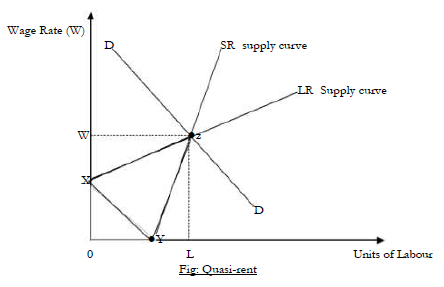Quasi-Rent:
These are factor rewards which are economic rent in the short-run and transfer earnings in the long run.
This is an amount earned by factors of production (other than land) in the short run when its
not possible to increase their supply.
May be defined as the payment made to a factor of production in the short run. This is when the
supply of the factor of production is less elastic than in the long-run because in the long run it can be
transferred to an alternative use.
Increased earnings in an occupation, for example, may lead to people undertaking the necessary
training in order to qualify for that occupation, thus reducing earnings in the long-run. Therefore,
quasi-rent may be defined as the amount earned only during the period which elapses before supply
increases.

In the figure, the area WXZ is the economic rent for labor. The area YLZ represents the transfer
earnings. The equilibrium (market) wage is OW and the number of workers (or hours worked) is OL.
The part of labor earnings which is economic rent in the short-run (SR) but transfer earnings in the
long-run (LR) is the quasi-rent and is represented by the shaded area OXZY.
Wilfykil answered the question on
February 6, 2019 at 09:58